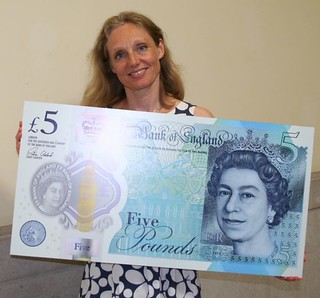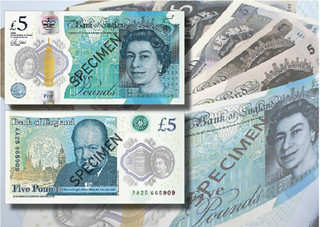
PREV ARTICLE
NEXT ARTICLE
FULL ISSUE
PREV FULL ISSUE
INTERVIEW: BANK OF ENGLAND’S VICTORIA CLELANDI'm a fan of Michael Alexander's in-depth numismatic reporting for Coin Update. And jealous that he can be in London.
Here's an exceprt of his October 10, 2016 interview with the Bank of England’s Chief Cashier Victoria Cleland about their new polymer banknotes.
-Editor
I had an opportunity to speak with Victoria Cleland, chief cashier of the Bank of England (whose signature appears on all Bank of England notes), before the note’s official launch date of September 13. She is directly responsible for insuring the integrity, safety, security, and overall supply of the country’s notes—among other accountabilities. We spoke about the behind-the-scenes of preparing for a new banknote, which posed more challenges than any ordinary change-over from one paper note to another due to the new polymer substrate being introduced. The newly launched “G” series of banknotes will continue to undergo change and addition; the upcoming £10 “Austen” note will also be printed on polymer, and it will be reduced in size to correspond with the new £5 note (which is 15% smaller than the 1990 version) and will change in design. The £20 denomination will also undergo change by 2020; it will include a portrait of 19th-century painter JMW Turner and will correspond to the new changes in terms of polymer substrate and size. It is clear that the Bank of England are poised to ensure that their notes are well suited to the demands the public expect of their banknotes as well as to guarantee their integrity, and have made great investment in this pursuit. The Bank seems to be looking long-term for continued banknote use, and where the demise of physical notes and coins are predicted to be the “norm” in other countries due to increasing electronic payment methods, don’t count out the pound in your pocket just yet where Bank of England notes are concerned. Michael Alexander: Hello Victoria, your department unveiled the newly anticipated £5 banknote on June 2, anticipated because of the inclusion of Sir Winston Churchill’s image on the reverse and of course, because it’s the Bank of England’s first note printed on polymer. My first question is when did the Bank of England decide that polymer would be used for this new series—what were the considerations behind the decision? Victoria Cleland: The Bank of England undertook a research project for about three years, really trying to understand the benefits of polymer compared to other banknote substrates. We looked at polymer, we looked at paper, and we looked at a number of hybrids between paper and polymer. The first one the team was looking at was whether or not polymer would give us increased counterfeit resilience. I think it’s very important to say, it’s not just the substrate, it’s the combination of the substrate and advanced security features that we’re trying to assess. My team spent a lot of time trying to literally counterfeit the notes themselves and they were quite good, quite brilliant. From that, it was essentially showing that polymer notes took longer to counterfeit and it was more difficult to come up with a good-quality polymer note with advanced security features than it was with paper—it’s really raising the bar for counterfeiters. We also looked at the life of the note and durability, and our tests found out that the polymer notes were cleaner and stronger. So actually, they’re more durable. I keep telling people “they are not indestructible, they’re more difficult to tear than paper ones, but then, it’s not impossible.” But they’ll actually last longer and they tend to stay cleaner. It’s one of the things we’ve had in the post was “we don’t like tatty fivers.” We thought while we have introduced polymer, it should be more difficult to counterfeit and no more tatty notes. We also found out that aside from the longevity, they had environmental impacts that were positive.  Cleland displays an oversized publicity mockup of the polymer note To read the complete article, see:  Wayne Homren, Editor The Numismatic Bibliomania Society is a non-profit organization promoting numismatic literature. See our web site at coinbooks.org. To submit items for publication in The E-Sylum, write to the Editor at this address: whomren@gmail.com To subscribe go to: https://my.binhost.com/lists/listinfo/esylum All Rights Reserved. NBS Home Page Contact the NBS webmaster 
|
